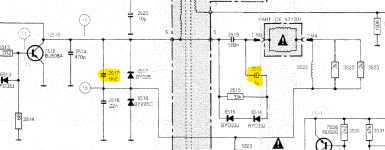The main thing that controls the overall brightness is the relative G1 grid to cathode voltage of the CRT. The cathodes are set by the video output stages. The G2 "grid" which is the first anode, will also affect it too. So it is a matter if testing those three voltages. If the cathode voltages are not very similar, it will cause a large color imbalance in the raster as one or more guns will be biased differently to the others. Probably, if the color balance is roughly right, the cathodes voltages will be correct (unless the fault is affecting the three video output stages identically), so it is just a matter of testing G1 and G2.
It could have been possible the one of the inductors 5524 or 5523 could have been making noise. As I recall there was a fault in one of these sets recently where the pot 3534 had stopped working and inductor 5524 was open circuit, so the East-West modulation had stopped. Though an O/C inductor would not be noisy.
(One tip about the flyback transformer's main primary tuning capacitors (these are on the collector of the H output transistor and transformer primary to ground) sometimes two are used in series, 8n2 & 22n in this case in this case.There is also a 470pF but that value is not as significant. Never disconnect them or alter their uF value. They determine the peak voltage of the flyback pulse and the EHT. If they go open circuit or are disconnected the peak flyback voltage goes very high, risking the H output transistor, the flyback transformer and the EHT diode inside it. Failure of these capacitor/s is a major disaster. They are also selected to be very high voltage type, typically with welded lead to plate construction)



